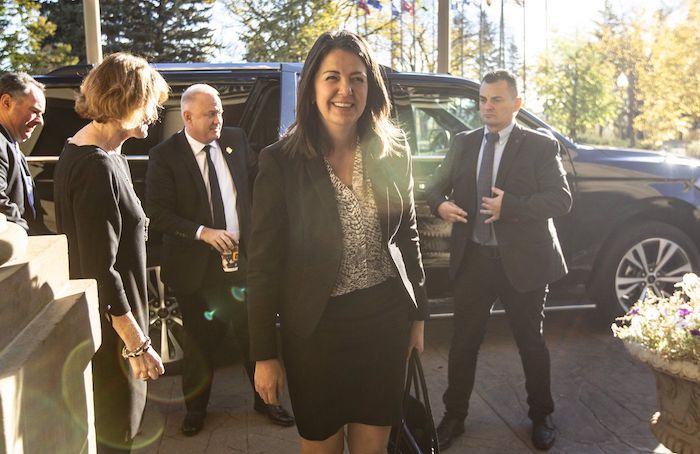Alberta
Premier Smith keeps foes in cabinet posts. Red Deer’s Adriana LaGrange remains Education Minister

Premier announces new cabinet
Alberta’s Premier has announced her new cabinet, with a focus on ensuring Albertans’ interests and priorities are well represented.
Twenty-four members of the Government of Alberta’s cabinet are being introduced to Albertans in advance of their taking the oath of office.
The new cabinet represents a strong mix of rural and urban MLAs from every geographic region of the province, each of whom the Premier recognizes as a strong advocate for their community and province. They are committed to standing up for Albertans, growing our economy and addressing affordability.
Joining the Premier and Minister of Intergovernmental Affairs in cabinet are:
- Deputy Premier and Minister of Skilled Trades and Professions – Kaycee Madu
- Deputy Premier and Minister of Infrastructure – Nathan Neudorf
- President of Treasury Board and Minister of Finance – Travis Toews
- Minister of Jobs, Economy and Northern Development – Brian Jean
- Minister of Justice – Tyler Shandro
- Minister of Health – Jason Copping
- Minister of Energy – Pete Guthrie
- Minister of Environment and Protected Areas – Sonya Savage
- Minister of Technology and Innovation – Nate Glubish
- Minister of Affordability and Utilities – Matt Jones
- Minister of Municipal Affairs – Rebecca Schulz
- Minister of Transportation and Economic Corridors – Devin Dreeshen
- Minister of Public Safety – Mike Ellis
- Minister of Agriculture and Irrigation – Nate Horner
- Minister of Forestry, Parks and Tourism – Todd Loewen
- Minister of Trade, Immigration and Multiculturalism – Rajan Sawhney
- Minister of Education – Adriana LaGrange
- Minister of Advanced Education – Demetrios Nicolaides
- Minister of Service Alberta and Red Tape Reduction – Dale Nally
- Minister of Indigenous Relations – Rick Wilson
- Minister of Seniors, Community and Social Services – Jeremy Nixon
- Minister of Children’s Services – Mickey Amery
- Minister of Mental Health and Addictions – Nicholas Milliken
- Minister of Culture – Jason Luan
“I am thrilled to being working with this strong, determined, united group of MLAs. Alberta’s future is bright – but there’s a lot of work to be done. Our team will work every day to gain your trust, make bold changes and continue to build the most innovative, entrepreneurial and welcoming province in the world. I want to thank our entire team for their tireless dedication to Albertans and we’re looking forward to the days ahead.”
Caucus leadership positions will include:
- Whip (Minister without portfolio) – Brad Rutherford
- House Leader (Minister without portfolio) – Joseph Schow
- Deputy House Leaders – Kaycee Madu, Mickey Amery, David Hanson
Ministers will be assisted in their work by the following parliamentary secretaries:
- Parliamentary Secretary for Ukrainian Refugee Settlement – Jackie Armstrong-Homeniuk
- Parliamentary Secretary for EMS Reform – RJ Sigurdson
- Parliamentary Secretary for Rural Health – Tany Yao
- Parliamentary Secretary for Economic Corridors – Shane Getson
- Parliamentary Secretary for Tourism – Miranda Rosin
- Parliamentary Secretary for Agrifood Development – Glenn van Dijken
- Parliamentary Secretary for Multiculturalism – Devinder Toor
- Parliamentary Secretary for Status of Women – Tanya Fir
- Parliamentary Secretary for Community Outreach – Muhammad Yaseen
- Parliamentary Secretary for Procurement Transformation – David Hanson
- Parliamentary Secretary for Small Business – Martin Long
New government committees will be chaired by:
- Economy and Affordability Cabinet Policy Committee – Jason Nixon
- Alberta First Cabinet Policy Committee – Garth Rowswell
- Social Services Cabinet Policy Committee – Searle Turton
- Building Communities Cabinet Policy Committee – Pat Rehn
- Legislative Review Committee Chair – Jason Stephan
Treasury Board members will include:
- Travis Toews
- Matt Jones
- Nate Glubish
- Rebecca Schulz
- Devin Dreeshen
- Jordan Walker
- Rick Wilson
- Nathan Neudorf
- Pete Guthrie
Cabinet members will be sworn in on the morning of Monday, Oct. 24 at 11 a.m. and will then begin receiving briefings from their departments.
Alberta
Low oil prices could have big consequences for Alberta’s finances

From the Fraser Institute
By Tegan Hill
Amid the tariff war, the price of West Texas Intermediate oil—a common benchmark—recently dropped below US$60 per barrel. Given every $1 drop in oil prices is an estimated $750 million hit to provincial revenues, if oil prices remain low for long, there could be big implications for Alberta’s budget.
The Smith government already projects a $5.2 billion budget deficit in 2025/26 with continued deficits over the following two years. This year’s deficit is based on oil prices averaging US$68.00 per barrel. While the budget does include a $4 billion “contingency” for unforeseen events, given the economic and fiscal impact of Trump’s tariffs, it could quickly be eaten up.
Budget deficits come with costs for Albertans, who will already pay a projected $600 each in provincial government debt interest in 2025/26. That’s money that could have gone towards health care and education, or even tax relief.
Unfortunately, this is all part of the resource revenue rollercoaster that’s are all too familiar to Albertans.
Resource revenue (including oil and gas royalties) is inherently volatile. In the last 10 years alone, it has been as high as $25.2 billion in 2022/23 and as low as $2.8 billion in 2015/16. The provincial government typically enjoys budget surpluses—and increases government spending—when oil prices and resource revenue is relatively high, but is thrown into deficits when resource revenues inevitably fall.
Fortunately, the Smith government can mitigate this volatility.
The key is limiting the level of resource revenue included in the budget to a set stable amount. Any resource revenue above that stable amount is automatically saved in a rainy-day fund to be withdrawn to maintain that stable amount in the budget during years of relatively low resource revenue. The logic is simple: save during the good times so you can weather the storm during bad times.
Indeed, if the Smith government had created a rainy-day account in 2023, for example, it could have already built up a sizeable fund to help stabilize the budget when resource revenue declines. While the Smith government has deposited some money in the Heritage Fund in recent years, it has not created a dedicated rainy-day account or introduced a similar mechanism to help stabilize provincial finances.
Limiting the amount of resource revenue in the budget, particularly during times of relatively high resource revenue, also tempers demand for higher spending, which is only fiscally sustainable with permanently high resource revenues. In other words, if the government creates a rainy-day account, spending would become more closely align with stable ongoing levels of revenue.
And it’s not too late. To end the boom-bust cycle and finally help stabilize provincial finances, the Smith government should create a rainy-day account.
Alberta
Governments in Alberta should spur homebuilding amid population explosion

From the Fraser Institute
By Tegan Hill and Austin Thompson
In 2024, construction started on 47,827 housing units—the most since 48,336 units in 2007 when population growth was less than half of what it was in 2024.
Alberta has long been viewed as an oasis in Canada’s overheated housing market—a refuge for Canadians priced out of high-cost centres such as Vancouver and Toronto. But the oasis is starting to dry up. House prices and rents in the province have spiked by about one-third since the start of the pandemic. According to a recent Maru poll, more than 70 per cent of Calgarians and Edmontonians doubt they will ever be able to afford a home in their city. Which raises the question: how much longer can this go on?
Alberta’s housing affordability problem reflects a simple reality—not enough homes have been built to accommodate the province’s growing population. The result? More Albertans competing for the same homes and rental units, pushing prices higher.
Population growth has always been volatile in Alberta, but the recent surge, fuelled by record levels of immigration, is unprecedented. Alberta has set new population growth records every year since 2022, culminating in the largest-ever increase of 186,704 new residents in 2024—nearly 70 per cent more than the largest pre-pandemic increase in 2013.
Homebuilding has increased, but not enough to keep pace with the rise in population. In 2024, construction started on 47,827 housing units—the most since 48,336 units in 2007 when population growth was less than half of what it was in 2024.
Moreover, from 1972 to 2019, Alberta added 2.1 new residents (on average) for every housing unit started compared to 3.9 new residents for every housing unit started in 2024. Put differently, today nearly twice as many new residents are potentially competing for each new home compared to historical norms.
While Alberta attracts more Canadians from other provinces than any other province, federal immigration and residency policies drive Alberta’s population growth. So while the provincial government has little control over its population growth, provincial and municipal governments can affect the pace of homebuilding.
For example, recent provincial amendments to the city charters in Calgary and Edmonton have helped standardize building codes, which should minimize cost and complexity for builders who operate across different jurisdictions. Municipal zoning reforms in Calgary, Edmonton and Red Deer have made it easier to build higher-density housing, and Lethbridge and Medicine Hat may soon follow suit. These changes should make it easier and faster to build homes, helping Alberta maintain some of the least restrictive building rules and quickest approval timelines in Canada.
There is, however, room for improvement. Policymakers at both the provincial and municipal level should streamline rules for building, reduce regulatory uncertainty and development costs, and shorten timelines for permit approvals. Calgary, for instance, imposes fees on developers to fund a wide array of public infrastructure—including roads, sewers, libraries, even buses—while Edmonton currently only imposes fees to fund the construction of new firehalls.
It’s difficult to say how long Alberta’s housing affordability woes will endure, but the situation is unlikely to improve unless homebuilding increases, spurred by government policies that facilitate more development.
-

 2025 Federal Election2 hours ago
2025 Federal Election2 hours agoThe Federal Brief That Should Sink Carney
-

 2025 Federal Election4 hours ago
2025 Federal Election4 hours agoHow Canada’s Mainstream Media Lost the Public Trust
-

 2025 Federal Election7 hours ago
2025 Federal Election7 hours agoOttawa Confirms China interfering with 2025 federal election: Beijing Seeks to Block Joe Tay’s Election
-

 2025 Federal Election6 hours ago
2025 Federal Election6 hours agoReal Homes vs. Modular Shoeboxes: The Housing Battle Between Poilievre and Carney
-

 John Stossel3 hours ago
John Stossel3 hours agoClimate Change Myths Part 2: Wildfires, Drought, Rising Sea Level, and Coral Reefs
-

 COVID-195 hours ago
COVID-195 hours agoNearly Half of “COVID-19 Deaths” Were Not Due to COVID-19 – Scientific Reports Journal
-

 2025 Federal Election2 days ago
2025 Federal Election2 days agoPolls say Canadians will give Trump what he wants, a Carney victory.
-

 2025 Federal Election2 days ago
2025 Federal Election2 days agoPoilievre’s Conservatives promise to repeal policy allowing male criminals in female jails




